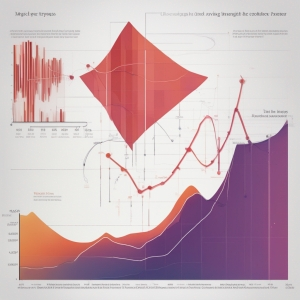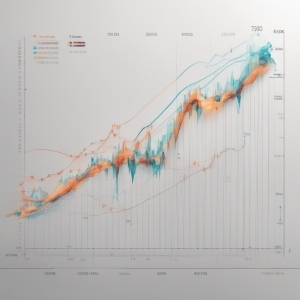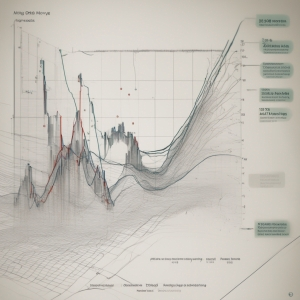Introduction: A Guide to Simplifying Price Data
The world of cryptocurrencies can often be complex and overwhelming, especially when it comes to understanding financial data. Whether you're a seasoned trader or a curious newbie, grasping the concept of moving averages is crucial to your financial literacy. In this article, we will discover the magic of moving averages: a tool that simplifies price data and provides clear signposts for your trading strategy.
Think of this as a starter's guide to deciphering those daunting charts and graphs frequently used in financial analyses. The focus here is on the concept of "Moving Averages Explained", including straightforward definitions, practical examples, and helpful tips on how to effectively use them in the realm of cryptocurrency trading. By the end of this article, moving averages will no longer seem like complex financial jargon but your ally in sound investment decisions.
Understanding Moving Averages: The Basics
Do not let the term "Moving Averages" intimidate you. In essence, a moving average is simply an average price data point of a specific time frame. Its purpose lies in smoothing out price fluctuations to help traders discern the overall trend direction over a period of time. This can be incredibly beneficial in making informed decisions and avoiding drastic actions due to momentary price changes.
The most common types of moving averages you will encounter are the Simple Moving Average (SMA) and the Exponential Moving Average (EMA). The SMA calculates the average of a selected range of prices, typically closing prices, over a specified number of time periods. EMA, on the other hand, places a greater weight and significance on the most recent data points. This makes the EMA more responsive to recent price changes.
While these methods may seem different, both are utilized to help traders identify potential buying and selling opportunities based on where price action is in relation to the moving average lines.
Pros and Cons of Moving Averages in Price Data Simplification
| Pros | Cons |
|---|---|
| Simplifies price data by creating a single flowing line | Not efficient for short-term investments due to the lagging nature |
| Useful in identifying the direction of the trend | May create false indications during fluctuating market conditions |
| Eliminates daily price fluctuations and focus on longer-term trend | Not suitable for securities that lack trend |
Types of Moving Averages: Simple and Exponential

The beauty of moving averages lies in its versatility. For this, let’s delve deeper into the two main types: the Simple Moving Average (SMA) and the Exponential Moving Average (EMA). These two methods, despite their slight differences, complement each other in providing comprehensive market insights.
The SMA is the most straightforward type. It is calculated by adding up the closing price of a crypto asset for a number of time periods and then dividing it by that same number of periods. This simple averaging smooths out short-term price fluctuations and highlights long-term trends, offering a clear picture of price movement over a specified period.
The EMA, on the flip side, brings a whole new dynamic to the table. It gives more weight to recent prices. This means that it responds more quickly to price changes than the SMA. Thus, the EMA offers a more current reflection of price trends, making it particularly useful for traders looking for short-term opportunities.
By combining the insights offered by both the SMA and the EMA, traders get a balanced view of the market's movements. The choice of which to use mainly depends on an individual's trading strategy and preference.
Applying Moving Averages in Crypto Trading
Moving averages can serve as a powerful tool in your trading arsenal. They can help identify opportunities to buy or sell crypto assets. When the price of a cryptocurrency crosses above its moving average, it could signal that the trend is shifting upwards. This might be a good time to consider buying. Similarly, when the price crosses below the moving average, it could indicate a downtrend, suggesting it might be a good time to sell.
However, it is important to remember that moving averages are lagging indicators. This means they are based on past prices, not predictive of future market movements. Therefore, they should not be used in isolation, but rather in conjunction with other trading indicators and strategies.
Harnessing the Magic: Key Takeaways

Understanding moving averages can significantly enhance your financial literacy and trading acumen in the realm of cryptocurrencies. They help to simplify complex price data into manageable trends, provide insight into potential trading opportunities and offer essential support to your decision-making processes.
Remember, while powerful, moving averages are just one tool. They are most effective when used in partnership with other indicators and strategies. Diversify your knowledge, stay informed, and enhance your trading capabilities by tuning into the magic of moving averages.
Importance of Using Moving Averages in Financial Analysis
Why pay attention to moving averages in financial analysis, you might ask. The application of moving averages is an excellent way to reduce market 'noise' and single out critical financial trends. The ability to focus on what’s important in the financial market is a substantial advantage, especially when dealing with volatile assets like cryptocurrencies. By smoothing out price variations, moving averages allow you to perceive long-term analyses with a clearer lens, helping you make better-informed investments.
Also, moving averages play a vital role in identifying critical support and resistance levels, which are essential to defining entry and exit points in trading. When the price of an asset meets resistance or support along its moving average line, it signifies possible turning points in its price trend. This insight is instrumental for traders in planning their next move based on the prevailing market data.
Given that cryptocurrencies are decentralized and open 24/7, managing and monitoring the multitude of available data can be daunting. The principle of moving averages provides an efficient solution by condensing past prices into helpful insights. From planning investment strategies to identifying market trends, moving averages have become indispensable tools in financial analysis.
Finally, remember that the magic of moving averages lies not in predicting but in responding to market trend changes. Thus, fostering vital insights on when to enter or exit the market. The power of moving averages represents a cornerstone of modern financial analysis, making it a subject worth mastering for anyone involved in trading and investing.
How to Calculate Moving Averages: Step by Step Explanation

Fear not if math isn't your strongest suit. Calculating moving averages is a skill anyone can acquire with a clear line of steps. In this section, we will walk you through the process of tabulating your very own Simple Moving Average (SMA), step-by-step:
Step 1: Choose your period. This could be any number of time frames, from one hour to one day to one month, depending on your trading preference. For instance, if you're interested in a more extensive price history, you might choose a 200-day SMA.
Step 2: Add up the closing prices. You'll need to add the closing prices of the cryptocurrency for each day (or your chosen time period) over the chosen period. So, if you selected a 200-day SMA, you'll be adding up 200 closing prices.
Step 3: Compute the average. Simply divide the sum of the closing prices from step two by the number of periods used (in our example, it's 200). The result is your Simple Moving Average.
Calculating the Exponential Moving Average (EMA) involves a bit more complexity due to the higher emphasis on recent price changes. However, worry not, as most trading tools and platforms perform these calculations for you, letting you focus on using the data to make informed decisions.
In essence, the process of calculating moving averages boils down to three straightforward steps. However, being proficient with this tool necessitates daily practice and continuous learning. Remember that it's essential to utilize moving averages in conjunction with other analytical tools for a well-rounded perspective on the market.
Application of Moving Averages in Cryptocurrency Trading
The dynamism of the cryptocurrency market, characterized by its volatility, makes the application of moving averages particularly salient. Through their capacity to smooth out price fluctuations, moving averages grant traders a clearer understanding of market trends amidst the turbulence.
Take a moment to imagine trading without a roadmap – chaotic, isn’t it? Moving averages serve as this navigational tool in an unpredictable market. When applied effectively, they delineate the paths in which cryptocurrency prices are headed, helping traders to forecast potential price breaks and reversals.
Popular tactics involve monitoring crossovers, where short-term moving averages (like the 50-day SMA or EMA) cross above or below long-term ones (such as the 200-day SMA or EMA). A bullish crossover happens when the short-term average goes above the long-term average, which might signal a good buying opportunity. Conversely, a bearish crossover, when the short-term average goes below, could present a chance to sell.
Beyond signal generation, moving averages can also define levels of support and resistance in the market. During strong upward or downward trends, altcoins often find support or resistance at the moving average lines, probing these levels multiple times before surging higher or dropping lower. This makes moving averages critical in timing entries and exits.
But do remember, just as moving averages can offer helpful signals, they can sometimes produce false ones. This highlights the need to complement moving averages with other technical indicators to enhance trading precision.
Moving Averages Explained: The Magic Behind
So how exactly does the magic of moving averages work? It is all about the power of simplification. By averaging out prices over a specific period and smoothing out price fluctuations, moving averages transform seemingly erratic data into steady and understandable trends.
Imagine watching a film with constant scene changes. It would be hard to make sense of the plot, won't it? Consider moving averages as the play button that allows the plot, or in this case, the price trends, to unfold in an observable progression.
The magic also lies in its adaptability. You can adjust the time frame as per your investing style. A long-term investor may choose to observe the moving averages of a larger period, such as 50 or 100 days, to evaluate long-haul trends. Short-term traders may stick to 5 or 10-day moving averages to act swiftly on quick market shifts.
Beyond trend identification, moving averages also serve as levels of support or resistance for price actions. Prices often rebound from these levels, adding another layer of dynamic analysis in your trading strategy.
Understanding moving averages equips you with multiple lenses to view the same market condition. This gives a multi-dimensional approach to your trading strategy, letting you enjoy the magic of moving averages to its fullest potential.
Potential Pitfalls and Risks of Relying on Moving Averages
Like any financial tool, moving averages also come with their share of risks and potential pitfalls. One must be aware of these to fully harness their power and use them effectively.
The first risk is the delay or "lag" associated with moving averages. Since these are based on past price data, they might not react instantly to volatile market conditions. This delay can sometimes result in false signals, causing a trader to enter or exit a trade at sub-optimal times.
Another potential pitfall is the possibility of 'overfitting'. This occurs when a trading strategy is excessively tailored to fit past performance, undermining its predictive capacity for future price movements. It's a common mistake made by traders who rely too heavily on moving averages.
Further, moving averages can become less effective in trending markets. If a market is in a strong uptrend or downtrend, the moving averages can lag behind actual price changes. In such scenarios, they might provide misleading signals, which can lead to investment missteps.
Lastly, it is pivotal to remember that moving averages do not predict the future trends but merely smooth out past data. Therefore, basing trading decisions solely on moving averages can lead to significant potential losses.
Consequently, while moving averages are a powerful tool, as with any investment strategy, remember to use other indicators and methods to validate signals. Diversification of strategies can help mitigate risks and enhance your cryptocurrency trading success rate.
Conclusion: The Power of Moving Averages in Price Data Simplification
In conclusion, the power of moving averages in the sphere of cryptocurrencies cannot be overstated. By smoothing out the erratic price fluctuations, they present data in a simplified and digestible manner. Whether its the responsive EMA providing a closer view of recent market behavior, or the SMA mapping out a broader perspective of long-term trends, they each contribute valuable insights into your trading strategies.
The understanding and utilization of moving averages equip traders with a sharper edge in interpreting the often tumultuous terrain of cryptocurrency markets. When used astutely, these tools can be instrumental in steering your decision-making process, helping you to capitalize on strategic market positions, and potentially steer clear of trading pitfalls.
As you continue on your journey in the dynamic world of cryptocurrency trading, the tool of moving averages is one to carry along in your knowledge arsenal. Their power to simplify complex price data into understandable figures presents an invaluable benefit for traders at all levels of expertise.
FAQ: Understanding the Power of Moving Averages
What are moving averages?
Moving averages are statistical calculations used to analyze sequences of data points by creating a series of averages of different subsets of data.
Why use moving averages in trading?
Moving averages can help traders identify trends and reversals, guide the timing of trade entries and exits, and provide potential support and resistance levels.
What is the difference between simple and exponential moving averages?
The main difference between these types is the weighting factors, which impacts the amount of importance given to the most recent data points. An exponential moving average gives more weight to recent data than a simple moving average.
How is a moving average calculated?
To calculate a moving average, you add up all the data points over a certain period, and then divide by the number of data points. This process is repeated as data moves forward.
What periods are commonly used in moving averages?
Common periods used in moving averages include 10, 20, 50, 100, and 200 days, but the timeframe can be adjusted depending on the trading strategy and time horizon.







